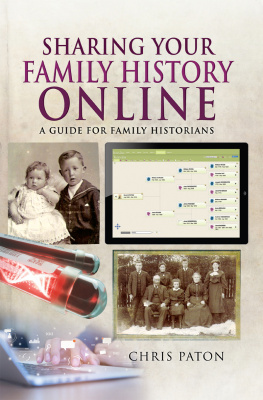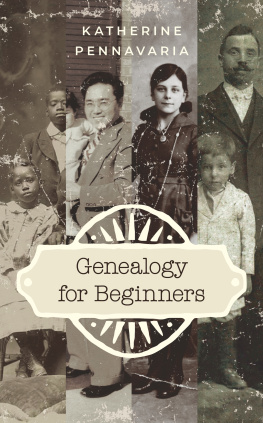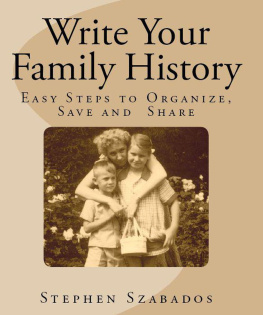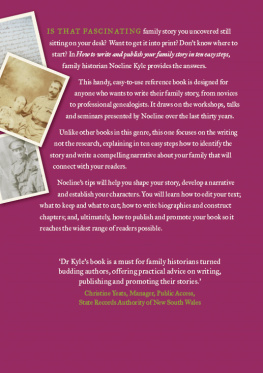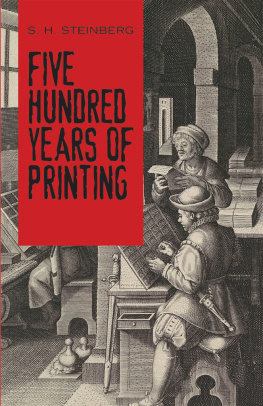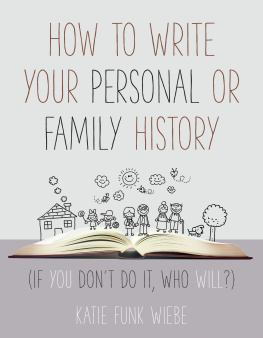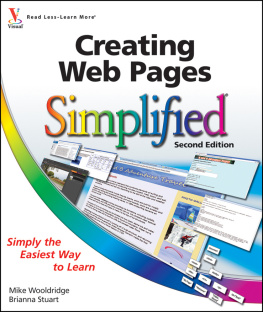
Publish
Your Family
History
GENEALOGISTS REFERENCE SHELF
Publish
Your Family
History
Preserving Your
Heritage in a Book
SUSAN YATES AND GREG IOANNOU

Copyright Susan Yates and Greg Ioannou, 2010
All rights reserved. No part of this publication may be reproduced, stored in a retrieval system, or transmitted in any form or by any means, electronic, mechanical, photocopying, recording, or otherwise (except for brief passages for purposes of review) without the prior permission of Dundurn Press and the Ontario Genealogical Society. Permission to photocopy should be requested from Access Copyright.
Editors: Heather Ball, Andrea Battiston, Jennie Worden
Printer: Webcom
Library and Archives Canada Cataloguing in Publication
Yates, Susan
Publish your family history : preserving your heritage in a book / by Susan Yates and Greg Ioannou.
(Genealogists Reference Shelf)
Co-published by the Ontario Genealogical Society.
Includes index.
ISBN 978-1-55488-727-9
1. Genealogical literature--Publishing. 2. Self-publishing. 3. Book design. I. Ioannou, Greg, 1953
II. Ontario Genealogical Society III. Title.
Z285.5.Y38 2010 070.593 C2009-907465-6
1 2 3 4 5 14 13 12 11 10

We acknowledge the support of the Canada Council for the Arts and the Ontario Arts Council for our publishing program.We also acknowledge the financial support of the Government of Canada through the Canada Book Fund and The Association for the Export of Canadian Books, and the Government of Ontario through the Ontario Book Publishers Tax Credit program, and the Ontario Media Development Corporation.
Care has been taken to trace the ownership of copyright material used in this book. The author and the publisher welcome any information enabling them to rectify any references or credits in subsequent editions.
J. Kirk Howard, President
Printed and bound in Canada.
www.dundurn.com
Ontario Genealogical Society
Suite 102, 40 Orchard View Boulevard
Toronto, Ontario, Canada M4R 1B9
tel. (416) 489-0734 fax. (416) 489-9803
provoffice@ogs.on.ca www.ogs.on.ca
Dundurn Press
3 Church Street, Suite 500
Toronto, Ontario, Canada
M5E 1M2 | Gazelle Book Services Limited
White Cross Mills
High Town, Lancaster, England
LA1 4XS | Dundurn Press
2250 Military Road
Tonawanda, NY
U.S.A. 14150 |
CONTENTS
11 Distribution
ACKNOWLEDGMENTS
Thanks to all the people who helped pull this book together: Ruth Chernia at the Ontario Genealogical Society (who came up with the idea and has fostered the project throughout), and the following people at Colborne Communications: Heather Ball, Andrea Battiston, Rachel Rosen and Jennie Worden.
Susan Yates
Greg Ioannou
SHARING
YOUR
RESEARCH
Researching family history is, for most of us, a labour of love. You are exploring your own background and the backgrounds of the people who mean the most to you. Many people reach a point where they want to share what they have found with their loved ones.The traditional way to do so is to put it all into the form of a book.
The whole notion of preparing a book is daunting. For one thing, books are long. Just writing a book is usually a huge undertaking.(We can tell you that with confidence.This is, after all, only the second paragraph of this bookwe know we have a l-o-n-g way to go!) With a family history, even when youve finished writing, you are faced with what can seem like an insurmountable group of tasks that you likely know little about: editing, design, typesetting, printing, binding, distribution.
Most people who want to publish a book follow a pretty traditional route: They write the manuscript and send it to agents or publishers, who send it straight back. It is an easy, if depressing,way to accumulate a fine collection of rejection letters. Perhaps luckily, that route isnt open to the writers of family histories. Few traditional publishers will consider publishing them, unless perhaps you are related to the Kennedys or Churchills.
There is another way, however, one that is open to more and more people, particularly because new technologies are making it cheaper and easier: publishing it yourself.This book explores the various ways of doing just that.We can help you publish your book, whether it is intended for a handful of close relatives or for a wider audience.
This book is designed for people who want to do it themselves, especially those whose publishing projects are on a small scale. Rather than using the term self-publishing, which has connotations of no one wanted to publish the thing so I just did it myself, weve used home publishing, to reflect the fact that most publishing projects outside of the mainstream book publishing industry are small-scale labours of love.
Your book can be handmade or professionally bound, can be handwritten or elaborately typeset.You can tailor the lookand the costto your particular needs and the needs of your readers. This book will lead you through the various options.
WHY DO YOU WANT TO
PUBLISH A BOOK?
First things first. Even though you arent going to be taking your family history to a traditional publisher, there is still a lot you can learn from how publishers operate. Lets ask some of the questions that publishers would ask of your manuscript. They are questions that need to be asked of any publishing project.
What Are You Trying to Communicate?
Many publishing projects dont really work because they have no central idea. Until that central idea has been thought through clearly, there is no point even starting to write the book. Many publishing projects should be shot down before they start, because the writer has no particular reason (other than ego gratification) for writing the book.
That applies to family histories too. Family histories range all the way from very dry family trees with little or no text to raunchy all the family dirt you were scared to ask about exposs. (One of the authors of this book has an aunt who, in her eighties, wrote a family history in which she was very explicit about exactly what she thought of various members of the family, and set the record straight about various events in the familys history. It makes wonderful readingfor some family members, anyway.)
A book with a weak central idea can often be improved by recasting that idea. For example, imagine that you have spent a lot of time researching your family tree and gathering documents related to your familys history.You decide to gather all of your research together to preserve it for the rest of the family.Your plan is to print out the family tree, then copies of all the documents sorted by type of document, and put it all into three-ring binders and give the binders to the members of your family.
Your family members eyes have always glazed over when youve shown them parts of the family tree, and have shown little interest in helping with your research. How likely are they to ever make any use of the binders?
The only way you have ever been able to get the family interested in your research is by telling them anecdotes about obscure relatives, like the time cousin Eustace woke up convinced hed inherited the Taj Mahal, and immediately left for India to claim his inheritance. That pretty much tells you what you have to do to prepare a family history that will preserve your research and that the family will treasure: combine the research with whatever youve been able to find out about the life stories of the people in your family.
Next page



